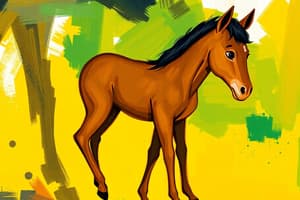Podcast
Questions and Answers
What is the primary function of the equine hindgut relevant to diarrhoea?
What is the primary function of the equine hindgut relevant to diarrhoea?
- Production of volatile fatty acids
- Absorption of undigested sugars
- Storage and absorption of water (correct)
- Fermentation of proteins
What is the correct definition of diarrhoea in horses?
What is the correct definition of diarrhoea in horses?
- A medical condition that affects digestion
- A disease characterized by dehydration
- An infection leading to loss of appetite
- A symptom with increased frequency of faecal output (correct)
Which of the following is a common cause of acute onset diarrhoea in horses?
Which of the following is a common cause of acute onset diarrhoea in horses?
- Parasite infestation
- Diet change
- Allergic reaction
- Clostridium difficile (correct)
What role do volatile fatty acids (VFAs) play in the hindgut of horses?
What role do volatile fatty acids (VFAs) play in the hindgut of horses?
Which condition should be considered in the differential diagnoses for diarrhoea in horses?
Which condition should be considered in the differential diagnoses for diarrhoea in horses?
Which of the following is NOT a common infectious cause of diarrhea in foals and weanlings?
Which of the following is NOT a common infectious cause of diarrhea in foals and weanlings?
What is a characteristic of Salmonella in horses?
What is a characteristic of Salmonella in horses?
Which of the following is classified as a non-infectious cause of equine diarrhea?
Which of the following is classified as a non-infectious cause of equine diarrhea?
In terms of zoonotic potential, which Salmonella serotype poses a risk?
In terms of zoonotic potential, which Salmonella serotype poses a risk?
Which of the following does NOT act as a toxicant leading to diarrhea in horses?
Which of the following does NOT act as a toxicant leading to diarrhea in horses?
Flashcards
Equine Hindgut
Equine Hindgut
A critical part of the digestive system in horses, responsible for storing and absorbing water. This function is essential for normal fecal consistency.
Equine Diarrhea
Equine Diarrhea
A symptom, not a standalone disease, characterized by increased water content in feces and more frequent bowel movements. The severity and presentation can vary.
Hindgut Fermentation
Hindgut Fermentation
The process of breaking down fiber by bacteria and protozoa in the hindgut. This produces valuable nutrients like volatile fatty acids (VFAs) and vitamins.
Volatile Fatty Acids (VFAs)
Volatile Fatty Acids (VFAs)
Signup and view all the flashcards
Infectious Agents
Infectious Agents
Signup and view all the flashcards
Salmonella
Salmonella
Signup and view all the flashcards
Salmonella in horses
Salmonella in horses
Signup and view all the flashcards
Foal Heat Diarrhea
Foal Heat Diarrhea
Signup and view all the flashcards
Aeromonas spp
Aeromonas spp
Signup and view all the flashcards
Lawsonia intracellularis diarrhea
Lawsonia intracellularis diarrhea
Signup and view all the flashcards
Study Notes
Approach to Equine Diarrhoea
- This presentation covers an approach to equine diarrhoea
- The presenter is Holly Lenagham, BVETMED, FHEA, MRCVS
- The presentation is for the University of Surrey
- The presentation is attributed to S. Kwon
Learning Objectives
- Apply core structure, function, and pathophysiology knowledge to common clinical scenarios
- Establish a holistic clinical approach to animals with diarrhoea, including detailed system-specific examinations
- Assess various clinical presentations, formulate differential diagnoses
- Develop diagnostic and prognostic skills for diarrhoea investigation
- Recommend appropriate medical/surgical interventions for diarrhoea management and disease prevention
Equine Hindgut Physiology
- The equine hindgut plays a key role in water storage and absorption
- It is the major site for water absorption
- Disruption in hindgut function can lead to diarrhoea
- The hindgut is a site of fermentation
- Fermentation produces volatile fatty acids, proteins, and vitamins
- It's susceptible to disturbance with large amounts of undigested sugars.
Equine Diarrhoea: Definition
- Definition: Diarrhoea is a symptom, not a disease, characterized by increased water content and frequency of faecal output
- Diarrhoea has various severities and clinical presentations
Equine Diarrhoea: Causes (Acute)
Acute Onset Diarrhoea
- Most acute cases are caused by infectious agents
- All horses: Salmonella spp., Clostridium difficile, C. perfringens, Aeromonas spp., Coronavirus, and larval cyathostomiasis (not in young foals)
- Foals and Weanlings: Foal heat diarrhoea, Rotavirus, Rhoddoccocus equi, Cryptosporidium, lactose intolerance, sepsis associated failure of passive transfer (FPT), Lawsonia intracellularis
- Non-infectious causes: antimicrobial-induced colitis, NSAID toxicity, grain overload, cantharidin, acorn, arsenic, sand enteropathy
Salmonellosis
- Gram-negative facultative anaerobes
- Horses are not carriers of Salmonella
- Equine cases often have few S. enterica serotypes
- Multidrug-resistant S. typhimurium DT104 and S. Newport are zoonotic
- Faecal shedding varies among groups and detection methods
Salmonellosis (Clinical Impact)
- Clinical impact varies based on exposure, virulence, and host immunity
- Subclinical case: usually non-pathogenic Salmonella spp.
- Mild infection: Fever, anorexia, depression, often with diarrhoea. Rapid recovery
- Acute enterocolitis: fever, anorexia, depression, diarrhoea, colic. Often has gastric reflux (gastric dilation and ileus syndrome)
- Septicemia/bacteraemia: endotoxaemia/SIRS, pneumonia, meningitis, septic arthritis, osteomyelitis
- Chronic case: following recovery from a severe infection
Salmonellosis (Diagnosis)
- Bacterial culture, faecal PCR, lateral flow test (multiple samples for sensitivity)
- Confirm isolates: antimicrobial sensitivity testing, serotyping, phage typing
Clostridiasis
- Gram-positive anaerobic spore-forming bacteria: the most common cause of nosocomial diarrhoea in horses
- Major toxins: Toxin A (enterotoxin), Toxin B (cytotoxin)
- Non-toxin-producing strains: Normal flora
- Faecal oral route: Opportunistic pathogens often linked to normal flora disturbance
Clostridiasis (Mechanism)
- Steps involve inhibitions, germmination, vegetative growth etc.
Equine Coronavirus (ECoV)
- Coronavirus family Group B enveloped ssRNA virus
- Faecal-oral route
- Clinical Significance is questioned. Often self-limiting; fatal cases reported with likely co-infections (e.g., salmonella, clostridia)
Larval Cyathostominosis
- Cyasthostomin (small strongyles/small redworm): A parasitic worm
- Clinical syndrome: Caused by mass emergence of encysted cyathostomin larvae from large intestinal walls
- Acute typhlocolitis with watery diarrhoea possible. Often a condition for young/old horses
- Seasonal (late winter and early spring)
Larval Cyathostominosis -Diagnosis
- Faecal tests: unreliable due to larvae being encysted
- Serum ELISA: Limited diagnostic value. Shows exposure but no current infection. False negatives possible.
- Can get false negatives.
Carbohydrate Overload
- Carbohydrates digested in the small intestine; excess entering the large intestine causes issues as too many VFAs and lactic acids lower the luminal pH
- Normal flora disturbance, pathogenic bacterial overgrowth, and endotoxin release are all possible outcomes
NSAIDs Toxicity
- NSAIDs routinely used in equine medicine; concern for inappropriate dosing or extended use; patient factors like dehydration or other illnesses
- Concern for equine gastric ulcers syndrome, right dorsal colitis (RDC)
Equine Diarrhoea: Clinical Findings
Dehydration and Hypovolaemia
- Diarrhoea can lead to substantial fluid loss
- Intra-cellular and extracellular spaces exist
- Various signs of dehydration including reduced urine output, tachycardia and impaired mucous membranes
- A large volume of fluid can be lost due to diarrhoea.
Protein Loss (Hypoalbuminaemia)
- Protein loss (especially albumin) from the gastrointestinal tract; resulting in signs of oedema
- Fluid imbalances, and other issues can also occur
Systemic Inflammatory Response Syndrome (SIRS)
- An exaggerated defence response to inflammation
- Clinical signs: Tachycardia, tachypnea, altered mucous membrane colour (e.g., white, brick red), pyrexia, delayed capillary refill
- Other signs include; reduced or absent urination, significant abdominal pain, ventral oedema, inappetence/weight loss, and potentially laminitis.
- Various possible causative factors include endotoxaemia, endotoxemic/septic shock, multi-organ dysfunction,
- A possible systemic reaction to bacterial infection.
Equine Diarrhoea: Clinical Signs (Chronic)
- Chronic diarrhoea: Signs can last for a few weeks or longer
- Often, the animal maintains hydration by drinking a lot. "Dirty hind" can be a clinical sign
- Weight loss another indicator
Equine Diarrhoea: Causes (Chronic)
- Inflammatory bowel disease (rare unless large colon involved)
- Granulomatous, eosinophilic, lymphocytic/plasmacytic
- Lymphoma (rare unless large colon involves)
- Sand enteropathy
- Re-modelling of intestinal barrier from colitis/typhlitis (possible)
- Non-GI causes: Peritonitis, liver disease
- Inflammatory Bowel disease related to granulomatous, eosinophilic, lymphocytic/plasmacytic and Lymphoma
Equine Diarrhoea: Diagnostic Approach
- Thorough history taking (onset, duration, changes in feed or care, medication, exposure)
- Comprehensive physical examination (mentation, signs of pain, TPR, mucous membrane colours, gut sounds, hydration status)
- Laboratory work (PCV/TP, peripheral blood lactate, CBC, platelets, electrolytes, other organ functions)
- Faecal examination (eggs, PCR, bacterial culture etc.)
- Imaging such as Ultrasound and Radiography
Equine Diarrhoea: Management
- Fluid therapy: Type of fluid (crystalloids, colloids), volume and rate of replacement/maintenance
- Anti-inflammatory, pain relief
- Toxin absorbent
- Laminitis prevention
- Antibiotics
- Other specific treatment (e.g., probiotics, faecal transfaunation)
- Biosecurity
- Specific treatment dependent on the underlying cause (e.g., salmonellosis, clostridiasis, lawsonia infection)
- Medications like NSAIDS, steroid/s, and other specific medications
- Treatment using products such as Psyllium husk; +/- MgSO4 and removing sand.
Studying That Suits You
Use AI to generate personalized quizzes and flashcards to suit your learning preferences.




